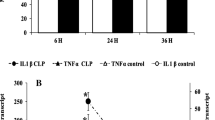Abstract
Time course changes in hepatic mitochondrial and peroxisomal fatty acid oxidative capacities, as well as changes in the related enzyme activities, were investigated in rats with sepsis induced by cecal ligation and puncture. Palmitoyl-L-carnitine oxidation was not altered, but carnitine palmitoyl-transferase (CPT) dependent palmitoyl-CoA (plus L-carnitine) oxidation was slightly increased in the liver mitochondria of the septic rats. Hepatic CPT activity, being the rate-limiting step of mitochondrial β-oxidation, was also enhanced by sepsis. In contrast, cyanide-insensitive peroxisomal β-oxidation and the carnitine acetyltransferase and catalase activities associated with the peroxisomal-enriched fraction were markedly reduced by abdominal sepsis. Cyanide-insensitive β-oxidation in control livers showed optimal specificity for lauroyl- and myristoyl-CoA and this pattern remained unchanged by sepsis. However, oxidation rates were reduced for all acyl-CoA esters tested, being more pronounced with longer carbon chain length acyl-CoA substrates. These results indicate that in early sepsis, hepatic mitochondrial fatty acid oxidative capacity was increased, probably due to enhanced CPT activity, whereas peroxisomal β-oxidation was seriously disturbed along with reduced catalase activity.
Similar content being viewed by others
References
Beisel WR, Wannemacher RW (1980) Gluconeogenesis, ureagenesis, and ketogenesis during sepsis. J Parenter Enteral Nutr 4:277–285
Wolfe RR, Shaw JHF, Durkot MJ (1985) Effect of sepsis on VLDL kinetics: Responses in basal state and during glucose infusion. Am J Physiol 248 (Endocrinol. Metab. 11):E732-E740
Chen WJ (1984) Utilization of exogenous fat emulsion (Intralipid) in septic rats. J Parenter Enteral Nutr 8:14–17
Lazarow PB, De Duve C (1976) A fatty acyl-CoA oxidizing system in rat liver peroxisomes; enhancement by clofibrate, a hypo-lipidemic drug. Proc Natl Acad Sci USA 73:2043–2046
Vary TC, Siegel JH, Nakatani T, Sato T, Aoyama H (1986) A biochemical basis for depressed ketogenesis in sepsis. J Trauma 26:419–425
Takeyama N, Takagi D, Matsuo N, Kitazawa Y, Tanaka T (1989) Altered hepatic fatty acid metabolism in endotoxicosis: Effect of L-carnitine on survival. Am J Physiol 256 (Endocrinol. Metab. 19):E31-E38
Takeyama N, Itoh Y, Kitazawa Y, Tanaka T (1990) Altered hepatic mitochondrial fatty acid oxidation and ketogenesis in endotoxic rats. Am J Physiol 259 (Endocrinol. Metab. 22):E498-E505
Canonico PG, White JD, Powanda MC (1975) Peroxisome depletion in rat liver during pneumococcal sepsis. Lab Invest 33:147–150
Canonico PG, Rill W, Ayala E (1977) Effects of inflammation on peroxisomal enzyme activities, catalase synthesis, and lipid metabolism. Lab Invest 37:479–486
Wichterman KA, Baue AE, Chaudry IH (1980) Sepsis and septic shock-A review of laboratory models and a proposal. J Surg Res 29:189–201.
Berge RK, Aarsland A (1985) Correlation between the cellular level of long-chain acyl-CoA, peroxisomal β-oxidation, and palmitoyl-CoA hydrolase activity in rat liver. Are the two enzyme systems regulated by a substrate-induced mechanism? Biochim Biophys Acta 837:141–151
Estabrook RW (1967) Mitochondrial respiratory control and the polarographic measurement of ADP:O ratios. Methods Enzymol 10:41–47
Garland PB, Shepherd D, Nicholls DG, Yates DW, Light PA (1969) Interactions between fatty acid oxidation and the tricarboxylic acid cycle. In: Lowenstein JM (ed) Citric Acid Cycle. Dekker, New York, pp 163–212
Flatmark T, Christiansen EN, Kryvi H (1981) Polydispersity of rat liver peroxisomes induced by the hypolipidemic and carcinogenic agent clofibrate. Eur J Cell Biol 24:62–69
Bieber LL, Abraham T, Helmrath T (1972) A rapid spectrophotometric assay for carnitine palmitoyltransferase. Anal Biochem 50:509–518
Aebi HE (1985) Catalase. In: Bergmeyer HU, Bergmeyer J, Braßl M (eds) Methods of enzymatic analysis. Enzyme 1: Oxidoreductases, Transferases, 3rd edn. Weinheim, FRG: VCH pp 273–286
Bradford MM (1976) A rapid and sensitive method for the quantitation of microgram quantities of protein utilizing the principle of protein-dye binding. Anal Biochem 72:248–254
Schumer W, Das Gupta TK, Moss GS, Nyhus LM (1970) Effect of endotoxemia on liver cell mitochondria in man. Ann Surg 171:875–882
Mela L, Bacalzo LV Jr, Miller LD (1971) Defective oxidative metabolism of rat liver mitochondria in hemorrhagic and endotoxin shock. Am J Physiol 220:571–577
Decker GAG, Daniel AM, Blevings S, Maclean LD (1971) Effect of peritonitis on mitochondrial respiration. J Surg Res 11:528–532
Fry DE, Silver BB, Rink RD, VanArsdall LR, Flint BS, Flint LM (1979) Hepatic cellular hypoxia in murine peritonitis. Surgery 85:652–661
Alexson SEH, Cannon B (1984) A direct comparison between peroxisomal and mitochondrial preferences for fatty-acyl β-oxidation predicts channelling of medium-chain and very-long-chain unsaturated fatty acids to peroxisomes. Biochim Biophys Acta 796:1–10
Neat CE, Thomassen MS, Osmundsen H (1981) Effects of high-fat diets on hepatic fatty acid oxidation in the rat: Isolation of rat liver peroxisomes by vertical-rotor centrifugation by using a self-generated, iso-osmotic, Percoll gradient. Biochem J 196:149–159
Kase F, Björkhem I, Pedersen JI (1983) Formation of cholic acid from 3α,7α,12α-trihydroxy-5β-cholestanoic acid by rat liver peroxisomes. J Lipid Res 24:1560–1567
Hajra AK, Burke CL, Jones CL (1979) Subcellular localization of acyl coenzyme A: Dihydroxyacetone phosphate acyltransferase in rat liver peroxisomes (microbodies). J Biol Chem 254:10896–10900
Halliwell B, Gutteridge JMC (1984) Oxygen toxicity, oxygen radicals, transition metals and disease. Biochem J 219:1–14
Mortensen PB, Kølvraa S, Gregersen N, Rasmussen K (1982) Cyanide-insensitive and clofibrate enhanced β-oxidation of dodecanedioic acid in rat liver: An indication of peroxisomal β-oxidation of N-dicarboxylic acids. Biochim Biophys Acta 713:393–397
Moser AE, Inderjit Singh AB, Brown III FR, Solish GI, Kelley RI, Benke PJ, Moser HW (1984) The cerebrohepatorenal (Zellweger) syndrome. N Eng J Med 310:1141–1146
Author information
Authors and Affiliations
Rights and permissions
About this article
Cite this article
Yamamoto, T. Rat liver peroxisomal and mitochondrial fatty acid oxidation in sepsis. Surg Today 23, 137–143 (1993). https://doi.org/10.1007/BF00311231
Received:
Accepted:
Issue Date:
DOI: https://doi.org/10.1007/BF00311231




